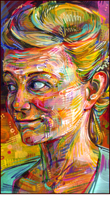 Gwenn Seemel is a portrait artist based in Portland, Oregon. She paints this cool stuff that takes Amerciana and works it into new ideas and forms. I’m a big fan and happy to her as a guest writer here at TheAbundantArtist.com. Visit her at GwennSeemel.com
Gwenn Seemel is a portrait artist based in Portland, Oregon. She paints this cool stuff that takes Amerciana and works it into new ideas and forms. I’m a big fan and happy to her as a guest writer here at TheAbundantArtist.com. Visit her at GwennSeemel.com
Making art on commission is an excellent way to connect with patrons in a more meaningful way. Though working with a client to develop an artwork can be a complex process, it doesn’t need to be intimidating. I find it helpful to keep a few things in mind when entering into a commission relationship:
1) I must be confident.
Clients want to feel like an artist knows what she-he is doing.
They are coming to me because of my skill and talent, and they don’t want to feel like they have to coddle me or do the work for me. It’s a given that they like my art, so, unless I give them cause to do otherwise, they will step aside and let me do what I do best.
And being confident is about more than my attitude during interviews and conversations with clients. It’s about demonstrating to patrons that my work is worthwhile and that, though I value their opinion, the finished work is mine, despite the fact that it physically belongs to them!
To that end, contracts–commission agreements as well as a model releases since I do portraits–are essential. Besides putting everyone on the same page about details like the date of delivery and the different parties’ rights to the image after the work and the money have exchanged hands, written agreements insure that clients see me as a professional. Contracts show that I take my work seriously and that their commission matters to me.
2) I must hang on my clients’ every word.
Clients constitute an artist’s most engaged audience. Because they are spending their money on my work, patrons tend to have a lot of opinions about it. They are an invaluable source of information about how my work is interpreted and understood. I take advantage of their interest in my oeuvre by asking them to talk about what they like and dislike in it. This feedback is generally useful, but also vital to the process of making a work for them specifically.
When I am discussing a commission with potential clients, I show them whatever paintings I have in my studio and sometimes supplement that with images of my work–anything to get them talking. On the other hand, my obvious confidence in my abilities establishes that what they tell me during this initial conversation is the extent of their input. They are not welcome to ask me to alter the work when I deem the painting complete, because it’s my work. This is a very different relationship from the designer-client one in which the maker’s creativity defers to the sponsor’s guidance, and I find that it’s important to establish that from the beginning.
3) I must be able to say ‘no’ if I’m not a good fit.
Clients don’t always pick the right artist.
Ideally every patron who’s looking to commission me would understand my work fully and only ever ask me to make paintings that I’m delighted to make, but that just isn’t the case.
I paint portraits, so, for the most part, the people who approach me about commissioning art are looking for the likeness of a loved one. That said, I often get requests to do a portrait as a surprise for its subject, something which I cannot do since I must meet and photograph my subjects myself in order to make a painting. In these cases, I explain to the potential clients how crucial my photo session is to the final painting and hopefully persuade them that the finished painting will be a surprise even if they subject knows it’s coming. However, if the patrons are too set on their idea to appreciate my process, I simply refer them to an artist who is happy work from photographs provided by clients.
To my mind, no amount of money is worth making a piece that I am not proud to call mine. If I lost sight of the purpose and philosophy of my work and did commission work simply to make a buck, I would be damaging my entire oeuvre.
The artist-patron relationship is an intricate one, blending business conventions with the artistic sensibilities of both the artist and the patron, but it is well worth it for both parties. My clients help me financially and “facially” to make work that I would never make otherwise, and the commission process allows them to feel especially attached to the work I make. It’s as intimate as an artist can get with her-his audience, and it keeps me connected to the core reason for making art: communication.
I can do almost anything in almost any art-stile. Go ahead and shoot.